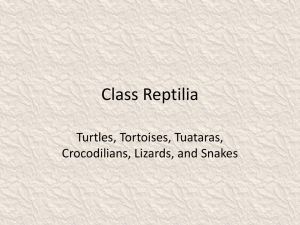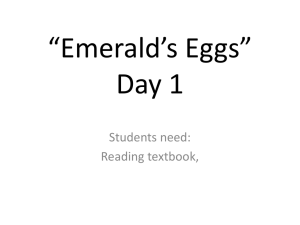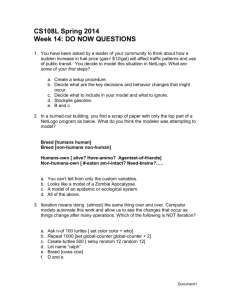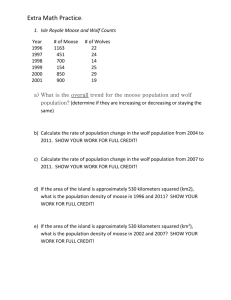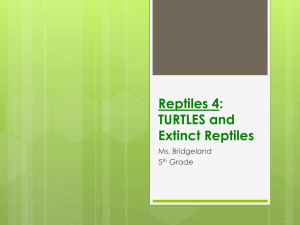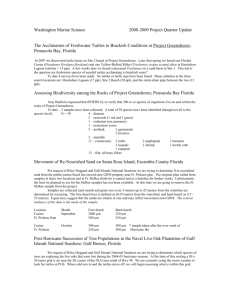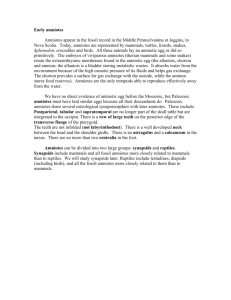7-Reptiles: Testudinia
advertisement
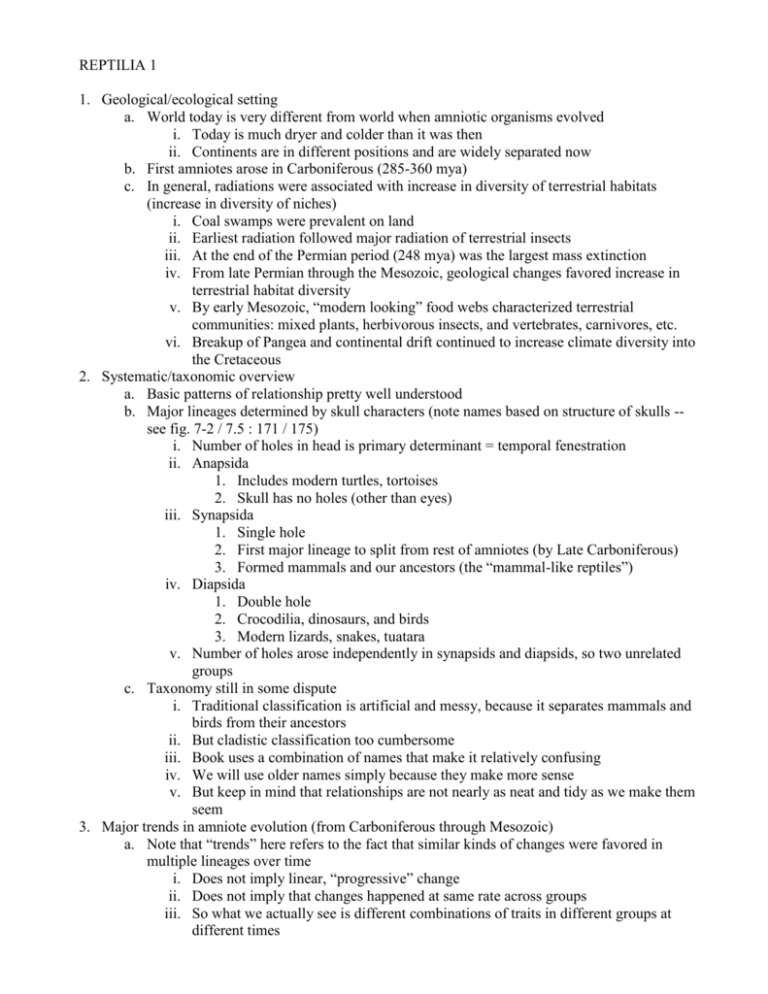
REPTILIA 1 1. Geological/ecological setting a. World today is very different from world when amniotic organisms evolved i. Today is much dryer and colder than it was then ii. Continents are in different positions and are widely separated now b. First amniotes arose in Carboniferous (285-360 mya) c. In general, radiations were associated with increase in diversity of terrestrial habitats (increase in diversity of niches) i. Coal swamps were prevalent on land ii. Earliest radiation followed major radiation of terrestrial insects iii. At the end of the Permian period (248 mya) was the largest mass extinction iv. From late Permian through the Mesozoic, geological changes favored increase in terrestrial habitat diversity v. By early Mesozoic, “modern looking” food webs characterized terrestrial communities: mixed plants, herbivorous insects, and vertebrates, carnivores, etc. vi. Breakup of Pangea and continental drift continued to increase climate diversity into the Cretaceous 2. Systematic/taxonomic overview a. Basic patterns of relationship pretty well understood b. Major lineages determined by skull characters (note names based on structure of skulls -see fig. 7-2 / 7.5 : 171 / 175) i. Number of holes in head is primary determinant = temporal fenestration ii. Anapsida 1. Includes modern turtles, tortoises 2. Skull has no holes (other than eyes) iii. Synapsida 1. Single hole 2. First major lineage to split from rest of amniotes (by Late Carboniferous) 3. Formed mammals and our ancestors (the “mammal-like reptiles”) iv. Diapsida 1. Double hole 2. Crocodilia, dinosaurs, and birds 3. Modern lizards, snakes, tuatara v. Number of holes arose independently in synapsids and diapsids, so two unrelated groups c. Taxonomy still in some dispute i. Traditional classification is artificial and messy, because it separates mammals and birds from their ancestors ii. But cladistic classification too cumbersome iii. Book uses a combination of names that make it relatively confusing iv. We will use older names simply because they make more sense v. But keep in mind that relationships are not nearly as neat and tidy as we make them seem 3. Major trends in amniote evolution (from Carboniferous through Mesozoic) a. Note that “trends” here refers to the fact that similar kinds of changes were favored in multiple lineages over time i. Does not imply linear, “progressive” change ii. Does not imply that changes happened at same rate across groups iii. So what we actually see is different combinations of traits in different groups at different times b. Result of these “trends” was/is: i. Increasing ecological diversity ii. Increased activity levels iii. Increased size c. Can divide “trends” into four major categories (but they are all interrelated) i. 1-Increasing adaptation to terrestrial environments 1. Amniotic egg (shared, derived character that defines the group) has a system of extra embryonic membranes (and usually a shell) 2. Modification of integument, including “waterproofing” ii. 2-Increase in locomotor efficiency 1. Early amniotes (and some modern forms) retain basic girdle structure and locomotor system as amphibians (fig 8.6 : 202) 2. Derived amniotes change to upright posture with limbs beneath the body. Advantages include a. Improved locomotor efficiency b. Frees trunk musculature to be used solely for ventilation of lung iii. 3-Increased feeding efficiency allows modifications of skull for wide range of food types; basic changes include 1. Lighten skull by decreasing the number and thickness of bones 2. Improve jaw mechanics (fig 8.14) iv. 4-Increase in metabolic efficiency = improve ability to acquire, deliver oxygen and nutrients to tissues 1. Big change to lungs: switch from buccal pump to aspiration lung, which is much more efficient than buccal pumping lung 2. Modification of heart, circulatory system (fig 8.10) a. Ventricle incompletely subdivided to provide “functionally” 4chambered heart b. Allows higher pressure systemic circuit (so improves oxygen, nutrient delivery) c. Because incompletely subdivided, permits flexibility in circulatory patterns, especially for divers (crocs, turtles) d. Summarize: amniotes “most successful” terrestrial vertebrates; radiations supported by i. Increase in the complexity of terrestrial habitats ii. Extinction of most previously dominant terrestrial vertebrates iii. Series of changes permitting radiation into full range of terrestrial niches 4. Testudinia – Turtles and Tortoises a. Systematics, diversity, and distribution i. The earliest fossils of turtles date to the late Triassic (210 mya) in the Mesozoic Era; relatively little major morphological change has taken place since that time ii. Modern turtles/tortoises include ~ 250 species in 13 families iii. Worldwide distribution and variety of habitats 1. Turtles/tortoises can be found on all continents except Antarctica 2. Can also be found in all warm and temperate oceans 3. Occupy a wide diversity of both terrestrial and aquatic habitats b. Form and function i. Skull is unique among modern reptiles by having a horny epidermal "beak" covering the dentary (major bone of lower jaw) ii. Most obvious characteristic = "shell" 1. A relatively heavy adaptation that can limit diversity 2. Composed of two parts 3. 4. 5. 6. 7. a. Carapace above b. Plastron below with 6 plates c. Two pieces connected via bony processes Both plastron and carapace have same basic structure a. Dermal bone beneath b. Epidermal (protein) scales (scutes) above Bones of the carapace are fused to the vertebrae and ribs, leaving the ribs outside the limb girdles – unique compared to ribs inside the girdles on all other tetrapods) In a number of species have hinged plastrons: front and rear lobes can be pulled upward to close openings for protection (in box turtles) In others, plastron is reduced in size, allowing greater mobility/agility: one species (musk turtle) can even climb several feet into trees to bask Variation in shell morphology is correlated with general differences in habitat and ecology a. Terrestrial species tend to have i. High domes ii. Broad, elephant-like feet iii. For example, the tortoises in the family Testudinidae b. Aquatic species tend to have i. Streamlined shells, often with reduced ossification ii. Webbed feet for swimming iii. For example, soft-shell turtles iv. Marine species show even greater reduction for reduced drag iii. Respiratory and circulatory systems 1. Heart is very complex a. Structurally i. Completely divided atria ii. Incompletely divided 3-chambered ventricle with flaps that separate oxygenated and deoxygenated blood b. Functionally, the arrangement permits i. Complete separation of oxygenated, deoxygenated blood during "normal" circulation ii. High pressure systemic and low pressure pulmonary circuits (lower resistance) iii. But also allows shunting of blood between systemic and pulmonary circuits (during diving for aquatic species) 2. Aquatic species a. When underwater for long periods b. May supplement lungs by performing gas exchange with water, using specialized epithelium of the pharynx c. Others open cloaca to suck in water d. Large sacks open from cloacal wall that are highly vascularized e. Pump water in and out of sacks for respiration c. Reproduction i. Turtles are long-lived, with relatively low reproductive rates ii. All are oviparous, with relatively long incubation periods and no parental care iii. Many exhibit temperature-dependent sex determination 1. This form of sex determination is found in many turtles, all crocodilians, and some lizards 2. Temperature during nesting determines sex of offspring 3. In general, the higher temperature produces the larger sex (so in turtles, high temperatures produce females) 4. Usually, each nest will produce predominantly individuals of one sex; multiple nests with different temperatures produces the overall sex ratio (usually 1:1) iv. All have internal fertilization v. Clutch size (number of eggs per nest) depends on species 1. Small species is 4-5 eggs 2. Large (especially marine) species is up to 100 eggs d. Ecology and behavior i. Migration 1. Finding nesting sites for terrestrial turtles a. In home range b. Usually based on knowledge of local landmarks c. Use sun for orientation 2. For sea turtles a. Have very strong nest-site fidelity b. Have remarkable ability to find nest site after foraging thousands of km away e. Conservation status and issues i. At least three groups of turtles are facing major conservation risks 1. Sea turtles 2. Large land tortoises (e.g., gopher tortoises in U.S.; Galapagos and Aldabara tortoises) 3. A whole variety of species now being exported for food and use in the exotic pet trade, with Asian species especially affected ii. Life history traits described above place turtles at risk generally 1. Low reproductive rates, long period before sexually mature, and lack of parental care mean recruitment of new individuals into populations will be slow 2. Many species are restricted to a single island; So any time conditions create high adult mortality, populations will be in trouble iii. Specific threats include (but not limited to) 1. Habitat loss and degradation 2. Overexploitation for food and the pet trade iv. According to 1996 Red List 1. Seven species Extinct 2. Two species Extinct in the Wild 3. 14 species Critically Endangered (facing an extremely high risk of extinction in the wild in the immediate future) 4. 33 species Endangered (not Critically Endangered but facing a very high risk of extinction in the wild in the near future) 5. 62 species Vulnerable (not Critically Endangered or Endangered but facing a high risk of extinction in the wild in the medium-term future) 6. One species is Lower Risk/Conservation Dependent (cessation of a taxonor habitat-specific conservation program will result in the taxon qualifying for one of the threatened categories above within 5 years) 7. 47 species Lower Risk/Near Threatened (don’t qualify for conservation dependent, but close to qualifying for vulnerable) 8. Note total = 166 out of ~ 250 species = 65% of extant species currently facing documented risk!
